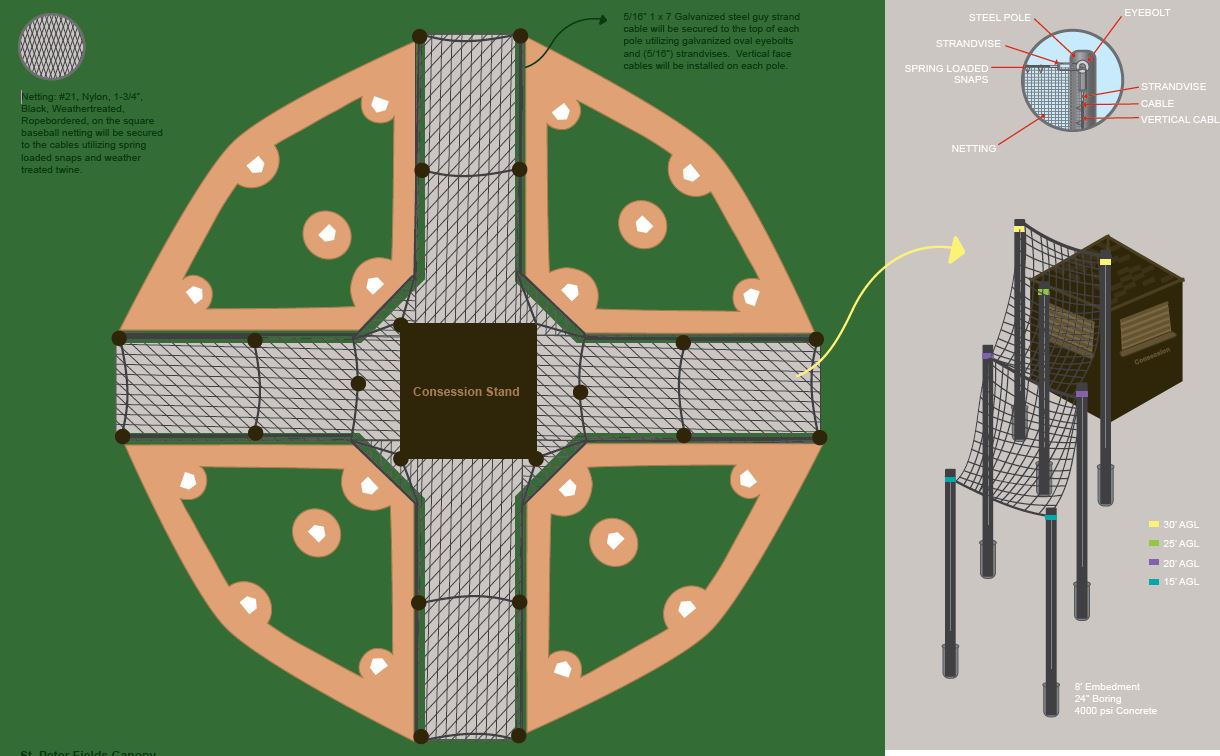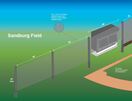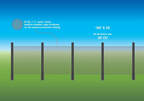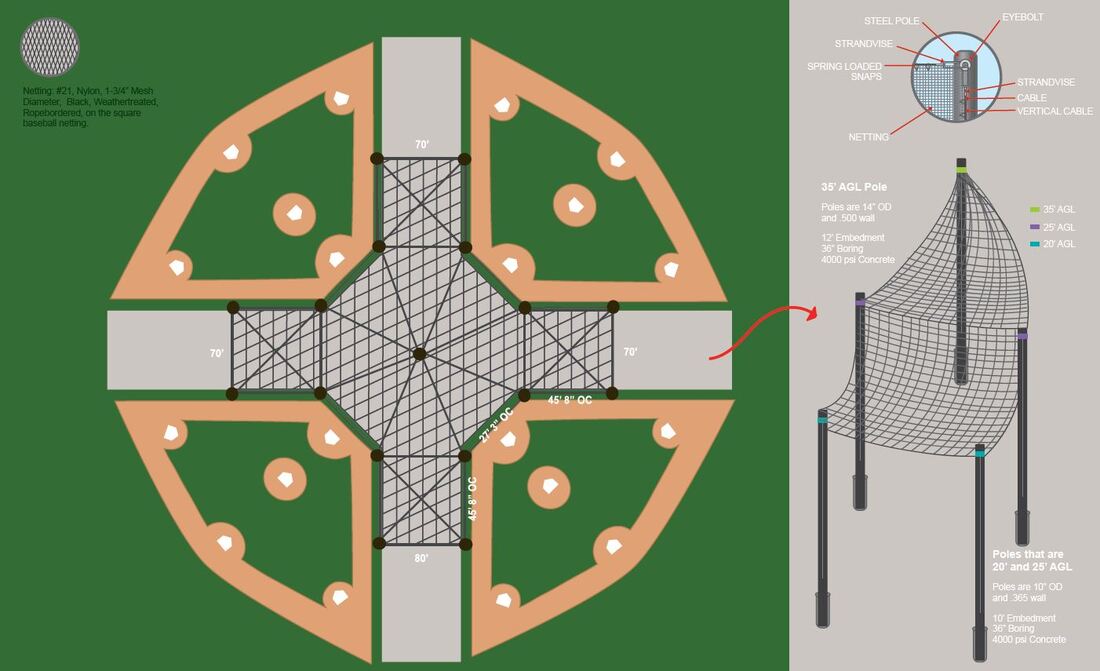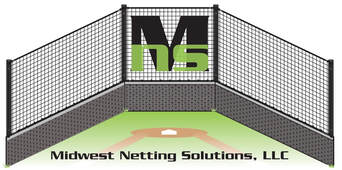Inline Tie Back Canopy Overhead Foul Ball Parking Lot Spectator Netting
What is baseball field protection backstop netting?Baseball backstop netting is a protective barrier made of durable and resilient net material that is placed behind home plate and along the baselines to prevent foul balls and flying bats from entering the stands and potentially injuring spectators. The netting is typically made of strong, weather-resistant materials such as polyethylene or nylon, and is designed to withstand the impact of high-speed baseballs and bats.
The height and width of the backstop netting can vary depending on the size of the baseball field and the specific requirements of the venue. In most cases, the netting will extend at least as high as the backstop and wrap around the entire home plate area and extend down the foul lines. Some ballparks may choose to extend the netting further down the lines, depending on their specific safety requirements. The netting is typically supported by a series of poles or cables that are securely anchored to the ground, providing a stable and secure framework for the netting to hang from. The mesh size of the netting can also vary, depending on the specific requirements of the venue, with smaller mesh sizes typically used in areas where there is a higher risk of injury to spectators. Overall, baseball backstop netting plays an important role in ensuring the safety of both players and spectators during baseball games, and is a vital component of any modern baseball field. |
|
Inline Baseball NettingInline backstop netting type of protective net fencing that is installed behind home plate and extends down both foul lines of a baseball field.
|
Tie Back Baseball NettingTie-back baseball backstop netting is the practical solution for schools, parks and recreational facilities looking to provide a safe and versatile netting.
|
Inline
|
Overhead
|
Field Protection NettingBaseball outfield protection netting refers to netting installed around the perimeter of a baseball softball outfield to protect fans from foul balls entering stands.
|
Parking
|
Spectator Safety
|
What is baseball netting?
Regulation softball and baseball backstop netting. MNS manufactures backstop batting nets for baseball using 1 7/8" (48mm) square mesh. This is the strongest netting for baseball and softball ball impact. Baseball netting and backstop netting has a break strength in excess of 150lbs. 3mm thick. All nets are weather resistant and are made to last about 5 to 10 years.
How much does baseball netting cost?
How much does baseball netting cost? Properly estimating the cost of a netting system has numerous variables that can significantly reduce or increase your overall project cost. For example, the total length of coverage, the height of the system, and the required structural integrity. Most foul ball protection netting systems span approximately 100 linear feet, which would be roughly sufficient in most ballparks to extend netting on either side of the existing netting system.
What are baseball nets made of?
MNS nets are made from DuPont grade 66-728 Twisted Knotted Nylon. UV Protected/weather treated, durable tar finishing. Nylon and polypropylene are durable and resistant to stress, but polypropylene is moisture and stronger than nylon..
What is HDPE baseball netting? Should we buy it. NO.
HDPE is high density poly-ethylene. HDPE has a high strength to density ratio. HDPE in netting will not hold up to extreme persistent weather elements including heat, dryness or snow. ... Typically HDPE is used in plastic bottles, corrosion resistant piping and plastic lumber.
How long does baseball netting last?
MNS nets are commercial grade quality. When properly installed our baseball nets may last up 10 years. Noncommercial grade nets are less than half the cost.
How tall is a baseball backstop?
MNS baseball backstop nets are circular in design and are high enough retain foul balls and poorly placed pitches. The regulation height, for high school ballparks and beyond, the backstop should be at least 25 feet tall.
What is #42 netting?
#42 Knotted Nylon Sports Barrier Netting from Twisted-Knotted Nylon. UV and Weather Treated to last indoors or outdoors. Hung on the square this netting has a mesh size of 1-7/8″. Each baseball backstop Net is reinforced with a 5/16″ rope border with a spring clip at each corner.
What is a backstop netting?
A baseball backstop is made from the netting behind home plate. Baseball backstops stop the ball from leaving the field. The backstop's purpose is to protect spectators from getting hurt by foul balls or even baseball bats that players through after hitting the ball.
How do you build a baseball backstop?
The backstop should have three sections. A long side that is about 15 feet wide that will be perpendicular to the line created by the pitcher's mound and home plate. Two more on either side should be at least 10 feet wide, and should be angled toward the base paths at approximately a 120-degree angle, or parallel to the foul lines. Depending on where you are in the US, 20-25 feet from front of home plate to the first point of the permanent backstop and recommended minimum of 40 feet. If less than 40 feet, the area six feet either side of the center of a line drawn from the mound through the plate shall be padded to deaden a deflecting ball. Such padding may be accomplished with a minimum of 2” closed cell foam padding. Backstop should not be of a design that the top or deflecting portion of the fence extends over the radius in the field diagram that encircles the batter’s box. (26’ diameter)
How do you install sports netting?
Netting installation hardware for batting cages or backstop netting installation begins with running the aircraft cable from pole to pole. Securing the cable to itself with cable clamps. After that is done, tension the cable with a turnbuckle. Add spring clips to the rope border of the net every 2 feet apart.
How do you measure a batting cage net?
The typical size of a batting cage net is 70 feet long by 14 feet wide by 12 feet high. This standard allows enough room for players to avoid creating back-swing contact with the netting. When it comes to an athlete's size, the distance between the pitcher's mound and home plate can differ.
Regulation softball and baseball backstop netting. MNS manufactures backstop batting nets for baseball using 1 7/8" (48mm) square mesh. This is the strongest netting for baseball and softball ball impact. Baseball netting and backstop netting has a break strength in excess of 150lbs. 3mm thick. All nets are weather resistant and are made to last about 5 to 10 years.
How much does baseball netting cost?
How much does baseball netting cost? Properly estimating the cost of a netting system has numerous variables that can significantly reduce or increase your overall project cost. For example, the total length of coverage, the height of the system, and the required structural integrity. Most foul ball protection netting systems span approximately 100 linear feet, which would be roughly sufficient in most ballparks to extend netting on either side of the existing netting system.
What are baseball nets made of?
MNS nets are made from DuPont grade 66-728 Twisted Knotted Nylon. UV Protected/weather treated, durable tar finishing. Nylon and polypropylene are durable and resistant to stress, but polypropylene is moisture and stronger than nylon..
What is HDPE baseball netting? Should we buy it. NO.
HDPE is high density poly-ethylene. HDPE has a high strength to density ratio. HDPE in netting will not hold up to extreme persistent weather elements including heat, dryness or snow. ... Typically HDPE is used in plastic bottles, corrosion resistant piping and plastic lumber.
How long does baseball netting last?
MNS nets are commercial grade quality. When properly installed our baseball nets may last up 10 years. Noncommercial grade nets are less than half the cost.
How tall is a baseball backstop?
MNS baseball backstop nets are circular in design and are high enough retain foul balls and poorly placed pitches. The regulation height, for high school ballparks and beyond, the backstop should be at least 25 feet tall.
What is #42 netting?
#42 Knotted Nylon Sports Barrier Netting from Twisted-Knotted Nylon. UV and Weather Treated to last indoors or outdoors. Hung on the square this netting has a mesh size of 1-7/8″. Each baseball backstop Net is reinforced with a 5/16″ rope border with a spring clip at each corner.
What is a backstop netting?
A baseball backstop is made from the netting behind home plate. Baseball backstops stop the ball from leaving the field. The backstop's purpose is to protect spectators from getting hurt by foul balls or even baseball bats that players through after hitting the ball.
How do you build a baseball backstop?
The backstop should have three sections. A long side that is about 15 feet wide that will be perpendicular to the line created by the pitcher's mound and home plate. Two more on either side should be at least 10 feet wide, and should be angled toward the base paths at approximately a 120-degree angle, or parallel to the foul lines. Depending on where you are in the US, 20-25 feet from front of home plate to the first point of the permanent backstop and recommended minimum of 40 feet. If less than 40 feet, the area six feet either side of the center of a line drawn from the mound through the plate shall be padded to deaden a deflecting ball. Such padding may be accomplished with a minimum of 2” closed cell foam padding. Backstop should not be of a design that the top or deflecting portion of the fence extends over the radius in the field diagram that encircles the batter’s box. (26’ diameter)
How do you install sports netting?
Netting installation hardware for batting cages or backstop netting installation begins with running the aircraft cable from pole to pole. Securing the cable to itself with cable clamps. After that is done, tension the cable with a turnbuckle. Add spring clips to the rope border of the net every 2 feet apart.
How do you measure a batting cage net?
The typical size of a batting cage net is 70 feet long by 14 feet wide by 12 feet high. This standard allows enough room for players to avoid creating back-swing contact with the netting. When it comes to an athlete's size, the distance between the pitcher's mound and home plate can differ.




